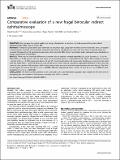Files in this item
Comparative evaluation of a new frugal binocular indirect ophthalmoscope
Item metadata
| dc.contributor.author | Kousha, Obaid | |
| dc.contributor.author | Ganesananthan, Sharma | |
| dc.contributor.author | Shahin, Bayan | |
| dc.contributor.author | Ellis, John | |
| dc.contributor.author | Blaikie, Andrew | |
| dc.date.accessioned | 2022-01-05T16:30:06Z | |
| dc.date.available | 2022-01-05T16:30:06Z | |
| dc.date.issued | 2021-12-23 | |
| dc.identifier | 277099443 | |
| dc.identifier | dffcf198-a237-4b3a-b04c-6c41189ca1ee | |
| dc.identifier | 85121657216 | |
| dc.identifier | 000734145800002 | |
| dc.identifier.citation | Kousha , O , Ganesananthan , S , Shahin , B , Ellis , J & Blaikie , A 2021 , ' Comparative evaluation of a new frugal binocular indirect ophthalmoscope ' , Eye , vol. Advance Access . https://doi.org/10.1038/s41433-021-01901-7 | en |
| dc.identifier.issn | 0950-222X | |
| dc.identifier.other | ORCID: /0000-0001-7913-6872/work/105957055 | |
| dc.identifier.uri | https://hdl.handle.net/10023/24601 | |
| dc.description | Funding: Ulverscroft Foundation; Global Challenges Research Fund. | en |
| dc.description.abstract | Objectives We compare the optical quality and design characteristic a new low cost solar powered binocular indirect ophthalmoscope (BIO), Holo, to Keeler BIO. Methods Twenty-four participants each examined 10 simulation eyes using both the Holo and the Keeler BIO with a 30-diopter condensing lens. Number of Lea symbols printed on the retina of simulation eyes seen and time taken to identify them was recorded. Stereoacuity of 12 participants was tested while using the BIOs. Using 7-point Likert scale, participants gave feedback on design characteristic of both BIOs. Results There was no statistical difference in number of Lea symbols correctly identified (15.63/20 for Holo vs. 15/20 for Keeler BIO, p = 0.366, paired t test) or time taken to correctly identify each symbol (Holo 0.39 s faster; 95% confidence interval −2.24 to 3.03 s, p = 0.763) using each device. 12 out of 12 participants achieved stereoacuity of 60 arcsec using the Holo while with the Keeler BIO 11 achieved 60 arcsec and one 90 arcsec. There was no statistically significant difference in the scores for clarity of view, quality of illumination, field of view, binocularity, eye strain and robustness between the two devices. The Holo, scored higher for ease of use (6.5 vs. 6, p = 0.00488, Wilcoxon signed-rank test), comfort of wear (6 vs. 5, p = 0.000337) and portability (7 vs. 6, p = 0.000148). Conclusion The Holo has the potential to be a clinically useful yet affordable diagnostic tool suitable for the first time of equipping eye care workers in low resource settings with a BIO at volume. | |
| dc.format.extent | 3 | |
| dc.format.extent | 485733 | |
| dc.language.iso | eng | |
| dc.relation.ispartof | Eye | en |
| dc.subject | RE Ophthalmology | en |
| dc.subject | NDAS | en |
| dc.subject.lcc | RE | en |
| dc.title | Comparative evaluation of a new frugal binocular indirect ophthalmoscope | en |
| dc.type | Journal article | en |
| dc.contributor.institution | University of St Andrews. School of Medicine | en |
| dc.contributor.institution | University of St Andrews. Sir James Mackenzie Institute for Early Diagnosis | en |
| dc.contributor.institution | University of St Andrews. Infection and Global Health Division | en |
| dc.identifier.doi | 10.1038/s41433-021-01901-7 | |
| dc.description.status | Peer reviewed | en |
This item appears in the following Collection(s)
Items in the St Andrews Research Repository are protected by copyright, with all rights reserved, unless otherwise indicated.

